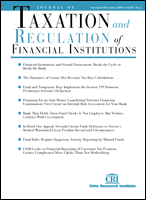Complete Issue
Author: Houman B. Shadab.
Source: Volume 25, Number 02, November/December 2011 , pp.1-64(64)

< previous article |return to table of contents
Abstract:
A government’s interest in collecting taxes requires taxpayers to make continual disclosures as a matter of course, and also to make additional disclosures in response to requests for information from tax authorities. The first two articles in this issue deal with law and policies surrounding government access to taxpayer information. In our first article, Payson Peabody examines the Internal Revenue Service’s recent Uncertain Tax Position initiative in light of several policies and bodies of rules, such as the Service’s right to access tax work product and the Financial Accounting Standards Board’s standard relating to accounting for uncertainty in business income taxes. He suggests what taxpayers can do to preserve the confidentiality of tax advice. Next, Gregory Bertsch and Benjamin Hughes address government access to taxpayer information in the context of bank secrecy. In particular, the authors examine the foreign bank account reporting requirement of the Bank Secrecy Act of 1970, and focus on recent changes and related compliance and enforcement issues. Banks and other lenders have to deal not only with tax-related compliance issues but also with a variety of risks and foregone opportunities. John Eggum, in our third article, discusses the importance of perfecting insurance proceeds so that lenders’ interests in bankrupt borrowers will not be undermined. Banks’ and other institutions’ mortgage practices in the years up to and after the financial crisis have sparked a wide variety of reforms, discussed in the issue’s fourth article, by David McElroy. Mr. McElroy covers a wide range of legal developments relating to mortgages, including changes brought about by the Dodd-Frank Act, actions by regulators, and litigation regarding the technical aspects of mortgage securitization. Next up, Frederic Giordano and Ashley Turner discuss how director and officer insurance can protect the principals of banks and other financial institutions. The authors note how the post-Dodd-Frank regulatory climate may have a particular impact on directors and officers at financial firms, due in part to actions pursued by financial regulators. Securitization does not always involve mortgages or credit assets, however, and in the issue’s sixth article, Jason Kreps and Thomas Lemmo discuss how patent assets can be monetized through securitization and collateralization techniques, with a focus on the potential problems arising from application of Article 9 of the Uniform Commercial Code. This issue concludes with a U.S./International column by Martin Cubasch, Elena Zafirova, and Lyubomir Georgiev, who note a development in Europe that may give U.S. banks some pause. The European Commission proposed a new preservation order rule over the summer, making it easier for creditors to recover assets across member state boundaries. If implemented, the banking affiliates or subsidiaries of U.S. institutions may be required to help effect the rule by complying with new types of orders from member states.Keywords:
Affiliations:
1: Journal Editor.